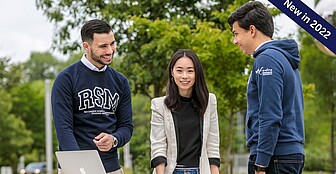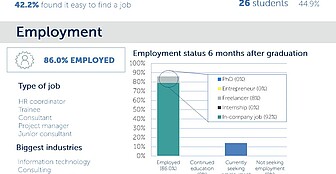
This website uses functional cookies, including analytical cookies. The obtained statistical data cannot be traced back to individual users. Additionally, you can choose to accept or refuse consent to use marketing cookies. If you decline these additional cookies or refrain from making a choice, only functional cookies will be set. See our cookie policy for more information.
Article: Wednesday, 3 February 2016
Management research has shown that involving customers in your product design can be an effective strategy. Muji furniture and Threadless apparel are just two examples of how powerful this strategy can be. Indeed, user-driven marketing strategies are being deployed widely by a growing number of corporations, from Dell's crowd-sourcing initiatives to Starbucks “Design your own Drink”.
While giving your consumers a voice can certainly create value, this is not always the case. A plethora of counter-examples can demonstrate how ineffectual user-driven tactics can be when applied in the wrong circumstances. So how, and when, is this a value-adding strategy?
Together with Darren Dahl from the University of British Columbia in Vancouver, and Martin Schreier from the WU Vienna University of Economics and Business, in Vienna, we designed a series of studies examining precisely when this strategy is effective. Previous studies have focused on evaluating the quality of user-driven products versus designer-driven; we wanted to identify consumer perceptions of these products, namely, the reasons why consumers display a preference for user-driven products and under what specific circumstances.

A growing number of companies look to their user communities for direction on new product ideas or improvements, and market them as “user-designed products".
Companies have typically depended on managers for decisions relating to products and product design (with or without input from market research). Now a growing number of companies look to their user communities for direction on new product ideas or improvements, and market them as “user-designed products” to the broader consumer market.
This strategy is both a smart response to an available resource and a compelling one. So great is the power of consumers today to influence sales and reputation that companies can and should engage with them in some form or another.
The firms that draw heavily on their users for everything from product design to marketing have earned themselves the moniker “user-driven firms”. The first of these to emerge were in the field of open-source software, where the unmet needs of a tech-savvy consumer community led to the development of open-source software that was created for users by users – a community of hobbyist programmers and professionals willing to donate their time and effort to designing statistical software. Along with it came the beginning of a revolution in the user/company relationship. Firefox is perhaps one of the greatest examples, relying on the input of users to set up and improve on existing browsers and subsequently becoming the dominant browser on the market.
In the years since, we have seen companies either embrace this trend by incorporating customers into their decision-making processes, or maintain traditional approaches to decision-making based on internal expertise. So what of these different approaches?
User-driven companies use their customer base to generate new ideas for innovative products, improve on existing products, and vote for the products that should be marketed on a constant basis. These companies rely strongly on their customers to create value and thus in the process, aim to narrow the gap between consumer needs and the end product.
A good example is Chicago-based t-shirt company Threadless, which outsources all t-shirt designs to its customers who then vote on the best designs, which are subsequently printed. The company has been one of the most innovative firms in the US.
More and more global organisations are incorporating user-driven aspects into their business strategies. These companies are recognising that in a society where consumers are interconnected and powerful, it is smart to integrate their voice into certain processes in the company. McDonald's recently held a competition inviting fans to create new burger recipes that were eventually sold in their restaurants.
But one size does not fit all when it comes to how companies can derive value from a consumer community. These tactics don't work for all products, or all companies. And now we have some insights into why.
In our research we found that consumers display a clear preference for products from user-driven firms over designer-driven firms only when the products are designed by users with whom they identify. In the case of users and product design, it all hinges on social identification.
Studies have shown that when people see others like themselves in positions of influence in a company, they experience a feeling of empowerment. This is a psychological phenomenon called basking in reflected glory. The theory is, even if you have not directly participated in anything, you could have, because the company has integrated people just like you.
Our research shows that this same phenomenon applies to consumers and user-driven product designs. Knowing people like themselves created these products leads consumers to identify with and thus express a preference for both product and company, even without having participated in the design of the product itself. In other words, consumers prefer products from user-driven firms when they feel they belong to similar demographics or social groups.
The effect is reversed when social identification is removed. If a company acquires the input of a group of users dissimilar to the broader customer base, a negative effect can be seen, where consumers prefer the products created by company designers than those of fellow and dissimilar product users.
But there are also other boundary conditions. Let's think of the example of cars or perhaps more specifically, car brakes. Most car buyers do not have the expertise to design car brakes, have never seen car brakes designed, and do not know anybody who could design them. In such a situation, user-designed car brakes would have significantly less appeal, where users are going to question the competence of the person who designed the product, as well as fail to relate to the designer.
Another interesting finding to come from our research is that the effect is diminished when the user-driven firm is selective in its choice of user participants. If the firm is not open to the input of every user, but only a selected group of users, a feeling of isolation or social exclusion for the observing consumers greatly diminishes any positive effect.
If a company acquires the input of a group of users dissimilar to the broader customer base, a negative effect can be seen.
The takeaway from this is that managers should look carefully at their customer base and the expertise within it before choosing how to give their consumers a voice in their organisation's processes. There are more ways than one of involving consumers.
Take the example of high-status, luxury brands. These companies would perhaps be wise to distance their consumers from the design process, where most consumers are not designers but rather aspire to the design expertise within the company, which is considered elite and high status. But this does not mean that the company cannot engage in other ways with their customers. Companies can give power to consumers via social media or by, for example, inviting them to participate in advertising campaigns.
With products that are less complex or where the product's consumers have considerable expertise in relation to the product, here we see room for involvement of users in the product design process and hence the creation of a positive effect of preference within the wider customer base. Coming up with software products is not easy, for example, but there are a great many people with expertise in programming. With less complex products, such in the categories of clothing, furniture, food, toys, garden products and so on, there is a great deal of room for user-driven input.
An effective tactic here is to use labelling to reveal the source of the design. Lego, for instance recently created a line of products labelled “created by Lego fans”, even inviting fans to vote on favourites and give feedback. In this way, the company entered a hypothetical relationship with their customers, making the products more attractive.
Of course, whether consumer preference for products from user-driven firms under these conditions translates into hard sales is an entirely different question. The implications of these perceptions for sales is a question we intend to answer with our latest research project, on which we are collaborating with Japanese design company Muji. But one thing that seems certain for now is that empowering your customers by giving them a voice in some area of your business, inevitably has a positive impact on your brand’s perception.
TUM School of Management

Prof. Fuchs holds the Chair of Marketing at TUM School of Management. His research interests include customer empowerment and integration, process and production innovation and consumer response to novel marketing strategies and tactics. His research has appeared in premier marketing and management journals such as the Journal of Marketing and Management Science and received prestigious awards including the Thomas P. Hustad Award for the best paper published in the Journal of Product Innovation Management in 2011. Professor Fuchs serves on the editorial review boards of the International Journal of Research in Marketing and the Journal of Product Innovation Management and as a reviewer for other leading journals (including the Journal of Marketing, Journal of Consumer Research, etc.).
Why and When Consumers Prefer Products of User-Driven Firms: A Social Identification Account, written by Darren W. Dahl, Christoph Fuchs and Martin Schreier and published in Management Science (STAR), 61(8):1978-1988.

Companies are increasingly drawing on their user communities to generate promising ideas for new products, which are then marketed as “user-designed” products to the broader consumer market. We demonstrate that nonparticipating, observing consumers prefer to buy from user- rather than designer-driven firms because of an enhanced identification with the firm that has adopted this user-driven philosophy. Three experimental studies validate a newly proposed social identification account underlying this effect. Because consumers are also users, their social identities connect to the user-designers, and they feel empowerment by vicariously being involved in the design process. This formed connection leads to preference for the firm’s products. Importantly, this social identification account also effectively predicts when the effect does not materialize. First, we find that if consumers feel dissimilar to participating users, the effects are attenuated. We demonstrate that this happens when the community differs from consumers along important demographics (i.e., gender) or when consumers are nonexperts in the focal domain (i.e., they feel that they do not belong to the social group of participating users). Second, the effects are attenuated if the user-driven firm is only selectively rather than fully open to participation from all users (observing consumers do not feel socially included). These findings advance the emerging theory on user involvement and offer practical implications for firms interested in pursuing a user-driven philosophy.



















Science Communication and Media Officer
Rotterdam School of Management, Erasmus University (RSM) is one of Europe’s top-ranked business schools. RSM provides ground-breaking research and education furthering excellence in all aspects of management and is based in the international port city of Rotterdam – a vital nexus of business, logistics and trade. RSM’s primary focus is on developing business leaders with international careers who can become a force for positive change by carrying their innovative mindset into a sustainable future. Our first-class range of bachelor, master, MBA, PhD and executive programmes encourage them to become to become critical, creative, caring and collaborative thinkers and doers.
